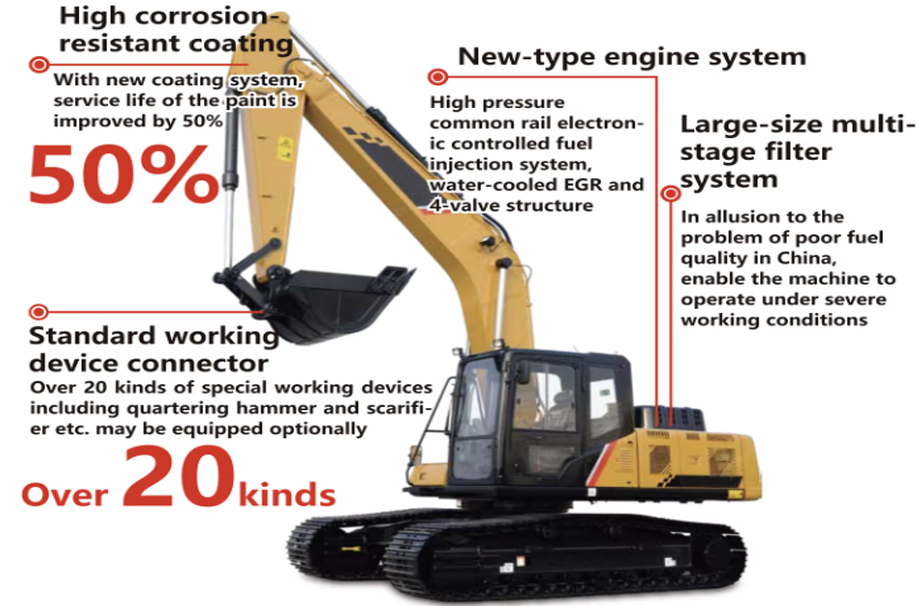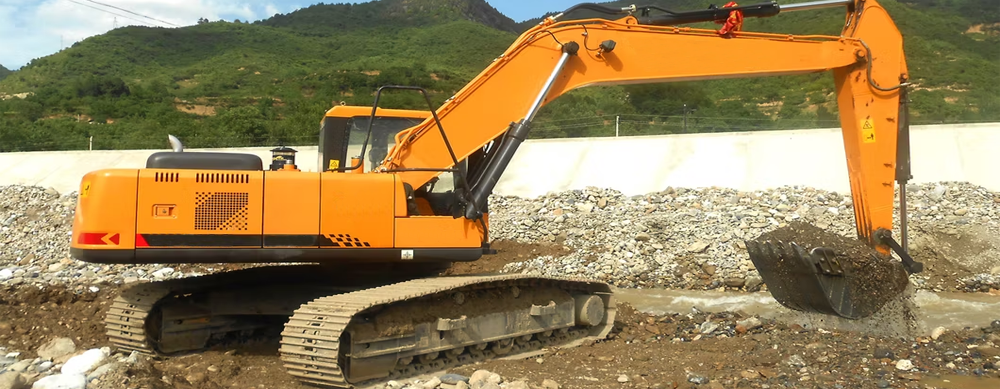Medium Excavators are a crucial part of construction and earthmoving fleets. They strike a balance between power and maneuverability. With a sturdier build than small excavators, they feature a durable steel frame capable of handling heavier loads. The hydraulic system is robust, precisely controlling the movement of the long boom and arm for efficient digging and lifting. These machines are equipped with a powerful engine, providing the necessary force to operate on various terrains. The operator's cab is designed for comfort, offering good visibility and ergonomic controls. Ideal for medium-sized construction projects, they can handle tasks like trenching, foundation work, and material loading with ease.
| Pictures |
|
|
|
|
|
|
|
| General parameters | |||||||
| Model | SY205C | SY200C | SY215C | SY215E | SY235H | SY245H | SY275H |
| Tonnage range | Medium excavator (13-30 tons) | Medium excavator (13-30 tons) | Medium excavator (13-30 tons) | Medium excavator (13-30 tons) | Medium excavator (13-30 tons) | Medium excavator (13-30 tons) | Medium excavator (13-30 tons) |
| Travel mode | Crawler | Crawler | Crawler | Crawler | Crawler | Crawler | Crawler |
| Bucket type | Backhoe | Backhoe | Backhoe | Backhoe | Backhoe | Backhoe | Backhoe |
| Application | General purpose | General purpose | General purpose | General purpose | General purpose | General purpose | General purpose |
| Power Type | Fuel | Fuel | Fuel | Battery | Fuel | Fuel | Fuel |
| Engine (fuel) | |||||||
| Type | 4-cylinder, 4-stroke, water-cooled, turbocharged | 4-cylinder, 4-stroke, water-cooled, EFI common rail, turbocharged | 4-stroke, water-cooled, direct injection, turbocharged | Inline, water-cooled, four-stroke, turbocharged | Inline, water-cooled, four-stroke, turbocharged | In-line six-cylinder, four-stroke, turbocharged intercooled, four-valve, water-cooled | |
| Rated power (kW) | 118 | 118 | 118 | 129/128 | 150 | 150 | |
| Rated speed (r/min) | 2000 | 2000 | 2000 | 2100/2000 | 2100 | 2100 | |
| Maximum torque (N·m) | 620 | 620 | 620 | 820 | 950 | 950 | |
| Total Displacement (L) | 4.899 | 4.899 | 4.899 | 5.7 | 5.7 | 5.7 | |
| Number of cylinders (pcs) | 4 | 4 | 6 | ||||
| Engine Brands | Mitsubishi | Mitsubishi | Mitsubishi | Deutz | Deutz | Deutz | |
| Emission standard | Euro 4 | Euro 4 | Euro 4 | Euro 4 | Euro 4 | Euro 4 | |
| Performance Parameters | |||||||
| Operating weight (kg) | 21500 | 21500 | 21900 | 22000 | 23000 | 25500 | 26900 |
| Bucket capacity (m³) | 1.0 | 1.0 | 1.1 | 1.1 | 1.35 | 1.4 | 1.65 |
| Travel speed (high/low) (km/h) | 5.3/3.2 | 5.4/3.4 | 5.4/3.4 | 5.6/3.5 | 5.8/3.7 | 5.8/3.7 | |
| Rotation speed (rpm) | 11 | 11.6 | 11.6 | 12.5 | 11.5 | 10 | 10.6 |
| Ground Specific Pressure (Kpa) | 47.4 | 47.4 | 47.4 | 51 | 52.5 | ||
| Climbing capacity (%) | 70 | 70 | 70 | 70 | 70 | 70 | |
| Bucket digging force (kN) | 126 | 128 | 138 | 138 | 140 | 175(187) | 175 |
| Movable arm length (mm) | 5700 | 5900 | 5900 | 5900 | |||
| Bucket Length (mm) | 2925 | 2950 | 2950 | 2950 | |||
| Dimension | |||||||
| L x W x H (transportation condition) (mm) | 9680×2800×3440 | 9680×2980×3440 | 9680×2980×3355 | 9910*2980*3440 | 9635×2980×3100 | 10290×3190×3255 | 10290×3190×3099 |
| Cab height (mm) | 3100 | 3100 | 3100 | 3255 | 3225 | 3255 | |
| Track Ground Length (mm) | 3360 | 3360 | 3445 | 3640 | 3640 | 3830 | |
| Overall track length (mm) | 4160 | 4160 | 4250 | 4446 | 4445 | 4640 | |
| Track plate width (mm) | 600 | 600 | 600 | 600 | 600 | 600 | 600 |
| Track gauge (mm) | 2830 | 2830 | 2380 | 2380 | 2380 | 2590 | 2590 |
| Minimum Ground Clearance (mm) | 470 | 470 | 474 | 440 | 442 | 470 | 440 |
| Minimum Turning Radius (Front End Unit) (mm) | 3730 | 3730 | 3730 | 3662 | 3800 | 3662 | |
| Rear Swing Radius (mm) | 2870 | 2870 | 2870 | 3125 | 2900 | 3105 | 3105 |
| Scope of operation | |||||||
| Maximum digging radius (mm) | 10280 | 10280 | 10280 | 10280 | 9745 | 10225 | 10225 |
| Maximum digging depth (mm) | 6600 | 6600 | 6600 | 6255 | 6450 | 6705 | 6705 |
| Maximum digging height (mm) | 9600 | 9600 | 9600 | 9600 | 9470 | 9745 | 9745 |
| Maximum unloading height (mm) | 6730 | 6730 | 6730 | 6730 | 9470 | 6715 | 6735 |
| Maximum vertical digging depth (mm) | 5675 | 5905 | |||||
| Fuel Volume | |||||||
| Fuel tank (L) | 370 | 370 | 370 | 370 | 440 | 440 | |
| Hydraulic oil tank (L) | 240 | 240 | 260 | 260 | 295 | 272 | |
| Engine Oil Change (L) | 20 | 20 | 20 | 25 | 25 | 25 |

1. The chassis of a medium excavator forms the backbone of the machine. It's fabricated from high-strength steel plates and beams, providing a rigid and stable foundation. The undercarriage typically consists of heavy-duty tracks, which offer superior traction and the ability to traverse rough terrains like muddy construction sites or rocky quarries.
2. The boom is a large, telescopic or fixed-length structure that extends from the upper part of the excavator's body. It's designed to provide vertical reach and can be adjusted in angle to position the bucket accurately.
3. The bucket is the working tool at the end of the arm. Medium excavators can be equipped with various types of buckets depending on the task. A general-purpose bucket has a flat bottom and curved sides for scooping loose materials such as soil, sand, and gravel.
4. The hydraulic system is the powerhouse that drives the excavator's movements. It comprises a hydraulic pump, usually driven by the engine. The pump pressurizes the hydraulic fluid and sends it through a network of hoses and valves to the hydraulic cylinders.
5. The cab provides a comfortable and protected space for the operator. It's designed with an ergonomic seat to reduce fatigue during long work hours. The controls are usually joystick-based, with one joystick for the boom and arm movements and another for the bucket and rotation.
6. The engine is the heart of the medium excavator, supplying power to the hydraulic pump and other systems. Medium excavators generally have diesel engines, known for their high torque output.

1. Digging Depth and Reach: Determine the specific digging depth and reach needed for your projects. If you're involved in deep-foundation work or trenching, ensure the excavator's boom and arm can achieve the required depths and horizontal reaches.
2. Material Handling Capacity: Consider the type and volume of materials you'll be handling. If it's heavy materials like rocks or large amounts of soil for loading onto trucks, you need an excavator with sufficient bucket capacity and lifting strength.
3. Operating Weight: The weight of the excavator affects its stability and mobility. A heavier machine provides more stability during digging operations but may be more difficult to transport.
4. Bucket Capacity: The bucket size determines the amount of material you can move in one cycle. A larger bucket capacity means higher productivity for tasks like loading and unloading.
5. Engine Power: Adequate engine power is crucial for efficient operation. A more powerful engine provides greater digging force and faster cycle times, which is beneficial for heavy-duty tasks.
6. Performance and Precision: A high-quality hydraulic system is vital for smooth and precise operation. Look at the flow rate of the hydraulic pump and the system pressure.
7. Operator Comfort: A comfortable cab with an ergonomic seat, good climate control, and enough space reduces operator fatigue.
8. Visibility: Clear visibility of the work area from the cab is essential. Look for large windows, well-placed mirrors, and, if possible, additional features like cameras to enhance the operator's view.

Medium excavators are equipped with powerful engines that provide high torque output. This enables them to handle a wide range of digging and loading tasks with ease. The combination of a robust engine and an efficient hydraulic system allows for strong digging forces and quick cycle times.
The boom and arm assembly of medium excavators offers excellent reach and flexibility. The boom can be adjusted in height and angle, and the arm provides precise horizontal movement. This allows for a wide range of digging depths and distances.
Built with a heavy-duty chassis and undercarriage, medium excavators are designed to withstand the rigors of construction work. The chassis, usually made of high-strength steel, provides a stable base.
The operator's cab is designed with comfort and functionality in mind. It features an ergonomic seat to reduce fatigue during long-working hours. The controls are intuitive and usually joystick-based, allowing for easy operation of the boom, arm, bucket, and other functions.
A well-designed hydraulic system is a key feature. It precisely controls the movement of the boom, arm, and bucket. The hydraulic pump pressurizes the fluid and distributes it through a network of hoses and valves to the cylinders.
Medium excavators are highly compatible with a variety of attachments. In addition to different buckets, they can be fitted with hydraulic breakers for breaking up concrete and rocks, augers for drilling holes, grapples for handling bulky or irregular materials, and compactors for soil compaction.

